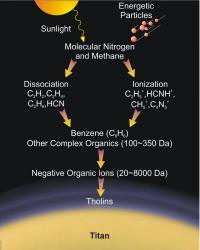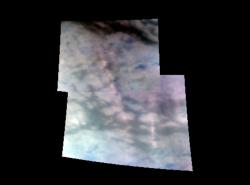Since the twin Voyager spacecraft flew past Saturn’s moon Titan, Scientists have been excited about what its hazy atmosphere can tell us about the earliest days of our own planet. The Voyagers discovered that Titan’s atmosphere is swirling with hydrocarbons and other complex organic molecules that could be the building blocks of life. The latest findings from NASA’s Cassini spacecraft have uncovered these organic molecules floating higher in Titan’s atmosphere than scientists originally thought possible.
This latest research has been published in the May 11, 2007 edition of the Journal Science. It shows that these organic aerosols, called tholins, have been found in altitudes higher than 1,000 kilometres (620 miles) above the surface of Titan. And these molecules are formed differently than how scientists originally believed.
This inquiry is important because the Titan’s environment is thought to be very similar to the Earth’s early history, before the first life formed. A similar process could have happened here.
Original Source: SwRI News Release


